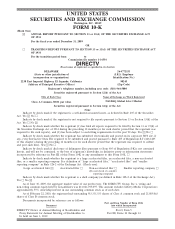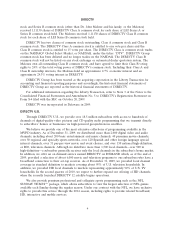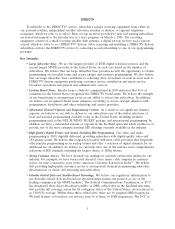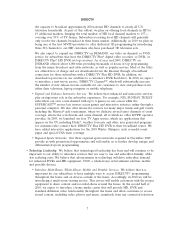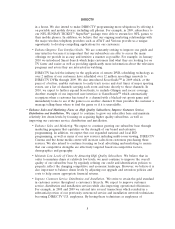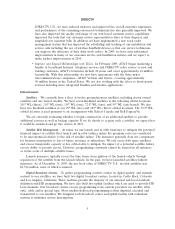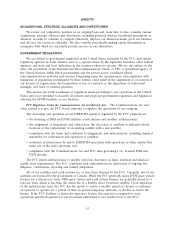DIRECTV 2009 Annual Report Download - page 21
Download and view the complete annual report
Please find page 21 of the 2009 DIRECTV annual report below. You can navigate through the pages in the report by either clicking on the pages listed below, or by using the keyword search tool below to find specific information within the annual report.DIRECTV
DIRECTV U.S., we have reduced turnover and improved the overall customer experience,
and performance of the remaining outsourced technicians has also generally improved. We
have also improved the quality and usage of our web-based customer service capabilities,
improved the tools that our customer service representatives have at their disposal, and
simplified our customer bills. In addition, we have implemented a new work order
management system that has improved the scheduling and tracking of our installation and
service calls including the use of wireless handheld devices so that our service technicians
can improve the efficiency of their daily work orders. In 2009, we have seen substantial
improvements in many of our customer service and installation metrics and we expect to
make further improvements in 2010.
•Improve and Expand Relationships with Telcos. In February 2009, AT&T began marketing a
bundle of broadband Internet, telephone services and DIRECTV video service to new and
existing customers. AT&T’s territories include 22 states and cover approximately 44 million
households. With this relationship, we now have agreements with the three major
telecommunications companies—AT&T, Verizon and Qwest—covering approximately
90 million homes in the United States. We are also working with the telcos to develop new
services including more integrated bundles and wireless applications.
Infrastructure
Satellites. We currently have a fleet of twelve geosynchronous satellites, including eleven owned
satellites and one leased satellite. We have seven Ku-Band satellites at the following orbital locations:
101⍭ WL (three), 110⍭ WL (one), 119⍭ WL (one), 72.5⍭ WL (one), and 95⍭ WL (one-leased). We also
have five Ka-Band satellites at our 99⍭ WL (two) and 103⍭ WL (three) orbital locations. The 72.5⍭ WL
orbital location is used pursuant to an arrangement with Telesat Canada and Bell ExpressVu.
We are currently evaluating whether to begin construction of an additional satellite to provide
additional services as well as backup capacity. If we do decide to acquire such a satellite, we expect that
it would be launched and go into service in 2013.
Satellite Risk Management. At times, we use launch and in-orbit insurance to mitigate the potential
financial impact of satellite fleet launch and in-orbit failures unless the premium costs are considered
to be uneconomical relative to the risk of satellite failure. The insurance generally does not compensate
for business interruption or loss of future revenues or subscribers. We rely on in-orbit spare satellites
and excess transponder capacity at key orbital slots to mitigate the impact of a potential satellite failure
on our ability to provide service. However, programming continuity cannot be assured in all instances
or in the event of multiple satellite losses.
Launch insurance typically covers the time frame from ignition of the launch vehicle through
separation of the satellite from the launch vehicle. In the past, we have launched satellites without
insurance. As of December 31, 2009, the net book value of DIRECTV U.S.’ in-orbit satellites was
$1,516 million, none of which is insured.
Digital Broadcast Centers. To gather programming content, ensure its digital quality, and transmit
content to our satellites, we have built two digital broadcast centers, located in Castle Rock, Colorado
and Los Angeles, California. These facilities provide the majority of our national and local standard-
definition and HD programming. We have also built five uplink facilities which are used to provide HD
local channels. Our broadcast centers receive programming from content providers via satellite, fiber
optic cable and/or special tape. Most satellite-delivered programming is then digitized, encoded and
transmitted to our satellites. We designed each broadcast center and uplink facility with redundant
systems to minimize service interruptions.
9


